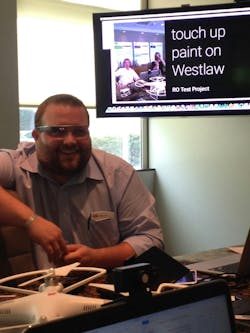Virtual reality in 3D models, iPhone thermal imaging: Inside one very cool tech toybox
A little over a year ago, I embarked on a search to find individuals in the AEC space who were putting new hardware to work in the field. After reading Dave Barista’s BIM 2.0 article highlighting industry leaders who were speculating about the next wave of innovation for AEC, I was inspired to start my journey. I looked for people who were putting these ideas into practical use and found such a person at Rogers-O’Brien. Todd Wynne, an Operations Technology Specialist, is tasked with finding new and innovative ways to go about the business of construction. Last year I covered his Google Glass project, which turned out to be one of my top three blog posts of all time. Based on this, I figured I can’t be the only one who is looking to know more about firms successfully piloting new hardware applications for the field.
After a full year of implementation and testing, I wanted to see what type of progress they’d made—which ideas had stuck and which ideas had fallen flat. I made the trip out to Dallas along with our VP of Product Management for some firsthand exposure to the cool technology being played with in the field.
First item on the agenda: find out how things were going with the Google Glass project. I was happy to learn that the project had produced a working prototype. Through integration with a field communication solution called FieldLens, Todd demonstrated how they use Glass to log issues in the field. Todd gave us a live demonstration, calling on Glass to wake up and access FieldLens, take a picture, dictate the message and send it off. He then showed how FieldLens distributed that information via news feed to all the project partners. Pretty cool stuff. Nice and simple, just the way the field wants it.
Todd and his team see this as only the beginning of integration opportunities between hardware and apps for communication to and from the field. There’s one hiccup, however. After logging many hours compiling feedback for Google with testing and real world usage, the trail has gone cold. Although they’ve reached out to share information with Google, there hasn’t been an effort to further the dialogue.
Although disappointed the feedback loop between Todd’s team and Google wasn’t working the way they’d hoped, Todd and his team had a table full of “toys” they were anxious to share with us. The approach they take is to look at technology affecting everyday life outside of the AEC industry and find ways to apply it. We’ve all seen the charts demonstrating just how unproductive the construction industry is. Well, Todd and his team are searching for ways other industries are applying technology and testing what can be applied to construction to move the needle on productivity and also find ways to communicate better overall.
Exploring ways to push the bounds of sharing design data with Virtual Reality hardware, they let us try two hardware virtualization products. Oculus Rift (www.oculus.com/) allows a user to step into the model, creating a first-person experience pioneered through gaming technology. Epson’s Moverio smart glasses (http://www.epson.com/cgi-bin/Store/jsp/Landing/moverio-bt-200-smart-glasses.do) are designed to convert 2D paper drawings into 3D elements. Each of these was high on the cool factor but not quite ready for primetime application in the field.
One technology that really showed promise of having a practical application today was an iPhone hardware add-on called FLIR ONE™ (http://www.flir.com/home/). Produced by a company called FLIR, it’s a device you snap onto your iPhone in order to read thermal data emitting from elements on the job site. For under $250 MEP contractors can use their iPhone to look through walls, piping and ducting to detect leaks, hot spots and potential energy leaks. The picture below was taken by Todd on the jobsite as he demonstrated the device for his HVAC trade partner. They were experiencing performance issues and couldn’t figure out where the issue was coming from. The contractor had a hunch it had something to do with a sharp 90-degree bend in the piping, but short of getting down into the suspended ducting, it was still a mystery. Todd pulled out his iPhone, attached the FLIR ONE, and in seconds they discovered the contractor’s hunch was correct. They were then able to justify the effort to get in and solve the issue, saving them valuable time by removing the guess work.
The final technology they shared with us was a Quadcopter currently being used to aid in weekly site reporting. Stay tuned to learn how this technology saved the project team $15,000 in warranty work.

